#Biodiversity in Agriculture
Text
Convent Capital AgriFood Growth Fund reaches EUR 100m in commitments
Amsterdam-based investment firm Convent Capital has invested in circularity since 2011 and launched its article 9 sustainable AgriFood Growth Fund in April 2022.
Convent is proud to announce the successful second close of its AgriFood Growth Fund now at EUR 100m. The increase includes a €10m commitment from the Dutch insurance company a.s.r.
The fund focuses on investing in innovative and…
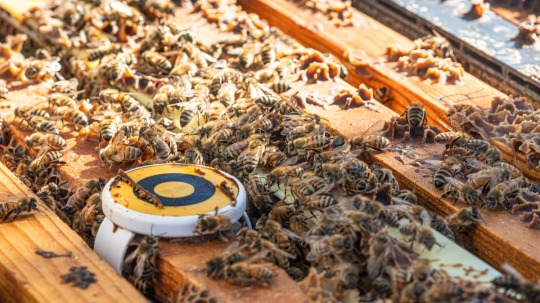
View On WordPress
#Agricultural Innovation#Agricultural Tech - Farming Tech#AgriFoodTech#AgTech and FoodTech Funding#Biodiversity in Agriculture#Food and Agribusiness#Food Processing#FoodTech#Sustainable Agriculture
0 notes
Text
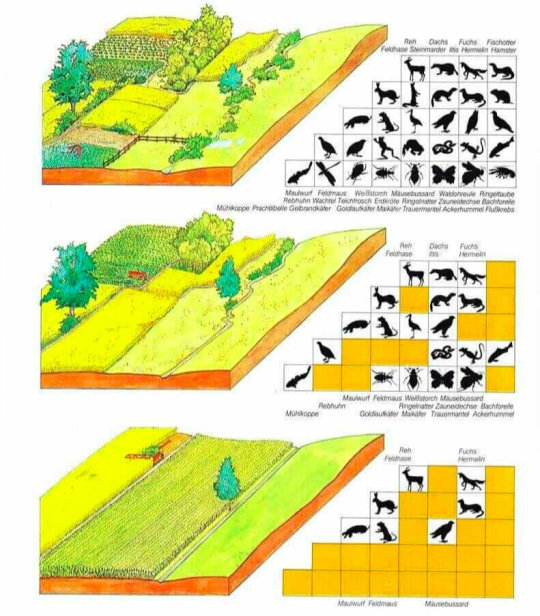
Diverse, well-integrated farms like coltura promiscua support significantly more native biodiversity than modern monocultures. Source: BUNDESAMT, F. U., & LANDSCHAFT, W. U. (1997). Umwelt in der Schweiz 1997. Berna, Buwal.
88 notes
·
View notes
Text
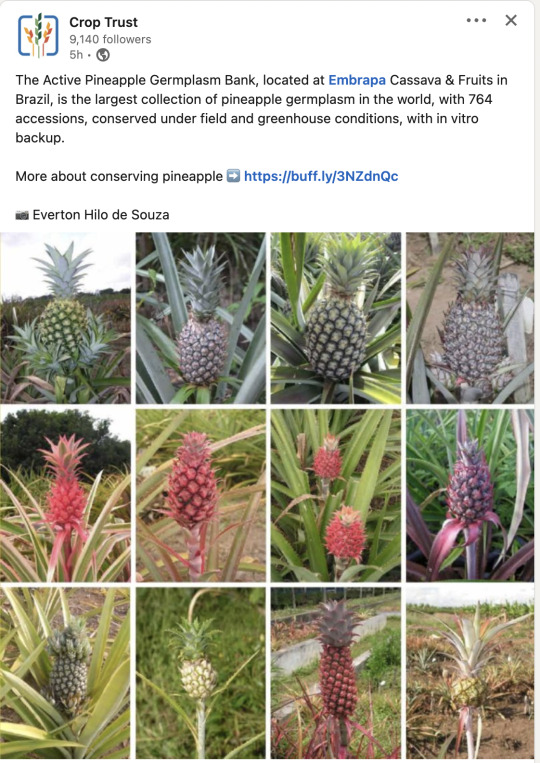
The surprising diversity of Pineapples (Ananas comosus).
The Active Pineapple Germplasm Bank (Pineapple AGB) of Embrapa Cassava & Fruits (Embrapa/ CNPMF) has more than 700 accessions under field conditions. As backups, there are copies kept in a greenhouse, with one or two plants per accession, cultivated in plastic pots with commercial substrate. An in vitro gene bank was established in 2003, and during the past few years, several studies have been carried out to improve the in vitro conservation protocol. Currently, about 60% of the AGB’s accessions are preserved by this protocol. Another conservation strategy used is cryopreservation of shoot tips and pollen grains, with well-defined methods. One of the most significant advances in the pineapple germplasm conservation has been the implementation of a quality control system, which enabled to define standard operation procedures (SOP) towards a more efficient and safer germplasm conservation.
Source:
Vidigal Souza, Fernanda & Souza, Everton & Aud, Fabiana & Costa, Eva & Silva, Paulo & Andrade, Eduardo & Rebouças, Danilo & Andrade, Danilo & Sousa, Andressa & Pugas, Carlos & Rebouças, Érica & França, Beatriz & França, Rivã. (2022). Advances in the conservation of pineapple genetic resources at Embrapa Cassava and Fruits. 28. 28-33.
#katia plant scientist#botany#plant biology#plant science#plants#fruit#pineapple#pineapples#biodiversity#agriculture#conservation#genetic diversity#sustainable agriculture#tropical plants#science#biology
312 notes
·
View notes
Text

Old school simplicity with new school flava.
#visionarygrowingsolutions#atlanta urban ag#compost#simple food small farmz#biodynamic#soil#biodiversity#soil biology#permaculture#urban ag#simplefoodsmallfarmz#simple food small farmz air bnb agriculture experience#small farmz simple food#simple food#simple things#soil fertility#soil food web#soil biodiversity#soil creation#atlanta airbnd experience#air bnb experience atlanta#atlanta air bnb urban agriculture experence#airbnb experience#maurice small
32 notes
·
View notes
Note
weird question, but do you know if regenerative agriculture is growing, and by what rate? it's important to me but looking for articles on my own can trigger a panic attack :[ no worries if not !
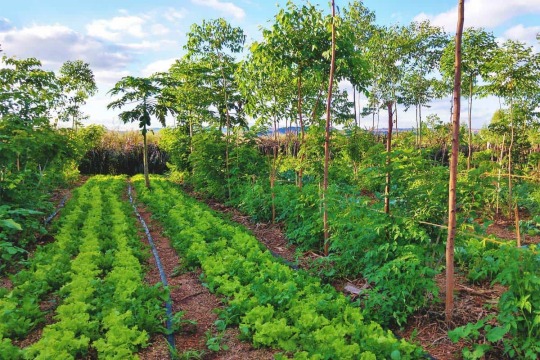
Hey! Thank you so much for asking. Honestly, agriculture and sustainable agriculture specifically are very close to my heart as well, so I was glad for the excuse to do some research :)
Also, thank you for your patience, I know you sent this Ask a bit ago. It’s good that you’re listening to yourself and not going around searching for things that might cause you harm, so thanks again for reaching out!
So, what is regenerative agriculture?
Regenerative agriculture is a way of farming that focuses on soil health. When soil is healthy, it produces more food and nutrition, stores more carbon and increases biodiversity – the variety of species. Healthy soil supports other water, land and air environments and ecosystems through natural processes including water drainage and pollination – the fertilization of plants.
Regenerative agriculture is a defining term for sustainability in our food system - while there is no one true definition of regenerative agriculture, the concept has been around for centuries, taking root in Indigenous growing practices. Regenerative approaches can bolster soil health and watershed health. They can also add to climate mitigation and potentially tie into regulatory or commercial incentives for a more sustainable diet.
Regenerative farming methods include minimizing the ploughing of land. This keeps CO2 in the soil, improves its water absorbency and leaves vital fungal communities in the earth undisturbed.
Rotating crops to vary the types of crop planted improves biodiversity, while using animal manure and compost helps to return nutrients to the soil.
Continuously grazing animals on the same piece of land can also degrade soil, explains the Regenerative agriculture in Europe report from the European Academies’ Science Advisory Council. So regenerative agriculture methods include moving grazing animals to different pastures.
How can it help?
Regenerative farming can improve crop yields – the volume of crops produced – by improving the health of soil and its ability to retain water, as well as reducing soil erosion. If regenerative farming was implemented in Africa, crop yields could rise 13% by 2040 and up to 40% in the future, according to a Regenerative Farming in Africa report by conservation organization the International Union for Conservation of Nature and the UN.
Regenerative farming can also reduce emissions from agriculture and turn the croplands and pastures, which cover up to 40% of Earth’s ice-free land area, into carbon sinks. These are environments that naturally absorb CO2 from the atmosphere, according to climate solutions organization Project Drawdown.
5 ways to scale regenerative agriculture:
1. Agree on common metrics for environmental outcomes. Today, there are many disparate efforts to define and measure environmental outcomes. We must move to a set of metrics adopted by the whole food industry, making it easier for farmers to adjust their practices and for positive changes to be rewarded.
2. Build farmers’ income from environmental outcomes such as carbon reduction and removal. We need a well-functioning market with a credible system of payments for environmental outcomes, trusted by buyers and sellers, that creates a new, durable, income stream for farmers.
3. Create mechanisms to share the cost of transition with farmers. Today, all the risk and cost sits with the farmers.
4. Ensure government policy enables and rewards farmers for transition. Too many government policies are in fact supporting the status quo of farming. The food sector must come together and work jointly with regulators to address this.
5. Develop new sourcing models to spread the cost of transition. We must move from sourcing models that take crops from anywhere to models that involve collaboration between off-takers from different sectors to take crops from areas converting to regenerative farming.
The rise of regenerative agriculture
In 2019, General Mills, the manufacturer of Cheerios, Yoplait and Annie’s Mac and Cheese (among other products), announced it would begin sourcing a portion of its corn, wheat, dairy and sugar from farmers who were engaged in regenerative agriculture practices and committed to advancing the practice of regenerative agriculture on one million acres of land by 2030. In early 2020, Whole Foods announced regenerative agriculture would be the No. 1 food trend and, in spite of the pandemic and the rapid growth of online shopping overshadowing the trend, business interest in the field still spiked by 138%.
More recently, PepsiCo announced it was adopting regenerative agriculture practices among 7 million acres of its farmland. Cargill declared it intends to do the same on 10 million acres by 2030, and Walmart has committed to advancing the practice on 50 million acres. Other companies pursuing regenerative agriculture include Danone, Unilever, Hormel, Target and Land O’ Lakes.
According to Nielsen, 75% of millennials are altering their buying habits with the environment in mind. This sentiment, of course, does not always materialize into tangible actions on behalf of every consumer. However, it is clear from the actions of PepsiCo, General Mills, Walmart, Unilever and others that they believe consumers’ expectations of what is environmentally friendly are shifting and that they will soon be looking to purchase regeneratively-produced foods because of the many benefits they produce.
The next step in the transition to regenerative agriculture is certification. The goal is to create labeling that will allow the consumer to connect to the full suite of their values. Some companies are partnering with nonprofit conveners and certifiers. The Savory Institute is one such partner, convening producers and brands around regenerative agriculture and more holistic land management practices.
In 2020, the Savory Institute granted its first “Ecological OutCome Verification (EOV) seal to Epic’s latest high protein bars by certifying that its featured beef was raised with regenerative agriculture practices.
The program was developed to let the land speak for itself by showing improvement through both leading and lagging functions such as plant diversity and water holding capacity. There are now thousands of products that have been Land to Market verified, with over 80 brand partnerships with companies such as Epic Provisions, Eileen Fisher and Applegate. Daily Harvest is giving growers in that space three-year contracts as well as markets and price premiums for the transitional crop. It's focusing on that transitional organic process as a stepping stone toward a regenerative organic food system.
Daily Harvest’s Almond Project creates an alliance with the Savory Institute and a group of stakeholders - including Simple Mills and Cappello’s - to bring regenerative practices to almonds in the Central Valley of California.
These companies are working with Treehouse California Almonds, their shared almond supplier, to lead soil health research on 160 acres of farmland. Over five years, the Project will focus on measuring outcomes around the ecosystem and soil health of regenerative practices – comparing those side by side with neighboring conventional baselines.
“We need industry partnership; we need pre-competitive collaboration,” says Rebecca Gildiner, Director of Sustainability at Daily Harvest, of the Almond Project. “Sustainability cannot be competitive. We are all sharing suppliers, we are all sharing supply – rising tides truly lift all boats. The industry has to understand our responsibility in investing, where historically investments have disproportionately focused on yields with a sole focus of feeding the world. We know this has been critical in the past but it has overlooked other forms of capital, other than financial. We need to look towards experimenting in holistic systems that have other outcomes than yield and profit - instead of saying organic can’t feed the world, we have to invest in figuring out how organic can feed the world because it’s critical.”
////
In short!!!
Many articles are stating regenerative agriculture as a defining, and rising “buzz word” in the industry. It seems that consumers are becoming more and more aware and are demanding more sustainable approaches to agriculture.
We, of course, have a way to go, but it seems from the data that I’ve gathered, that regenerative agriculture is, in fact, on the rise. Demand is rising, and many are working on ways to globalize those methods.
Source Source Source Source
#climate change#climate#hope#good news#climate news#climate crisis#more to come#climate emergency#news#climate justice#agriculture#ecosystem#farming#conservation#biodiversity#regenerative agriculture
81 notes
·
View notes
Text
Last Wednesday night, Britain was robbed of one of its best-loved trees. Mike Pratt, the CEO of Northumberland Wildlife Trust, describes the venerable, now-recumbent sycamore at Sycamore Gap on Hadrian’s Wall as a “totem tree; a touch point in the landscape”.
But the tree, standing alone in a national park, also reminded some of how nature-depleted England is. As environmentalist Ben Goldsmith said at the time: “That someone would have destroyed this iconic tree is beyond comprehension; but what’s even more shocking is that this was pretty much the only tree in that entire landscape. Our national parks can and should be so much better.”
According to Northumberland Wildlife Trust’s latest estimates, just 7% of Northumberland meets the criteria needed for the UK government to fulfil its commitment to protect and prioritise 30% of the landscape for nature by 2030 – which is a little higher than the 5% average across England as a whole.
While Goldsmith overstates the case somewhat, low tree cover does partly explain why Northumberland is sometimes called the “land of far horizons”. The most remote and least populated of England’s national parks, its rolling hills are swathed by expansive areas of open moor, peatland, as well as large forestry plantations.
In common with most other national parks in Britain, much of this land is grazed by sheep and cattle. As Pratt explains, over decades and centuries, agriculture has gradually become more intensive, with the result that areas of the national park are now almost devoid of trees and “feel a little bit industrial in parts”, he says. This is not the fault of individual farmers, Pratt argues. “It’s just that no one’s ever made any big decisions about what it should look like, probably since Roman times.”
Now, the felling of the tree at Sycamore Gap has given local communities and land managers a reason to reflect on, and make some serious choices about, how this landscape should look and function in the years to come.
A vision of renewal
From Pratt’s perspective, the corridor of land that roughly follows Hadrian’s Wall, from England’s east coast to west, is “possibly the biggest opportunity for a wilder landscape in England”.
On Wednesday, Northumberland national park authority announced its plans for how one part of that corridor would be renewed, with a new project signalling “a transformative shift towards a nature-first approach to land management”.
The project has been two years in the planning, but unveiling it this week, in the immediate aftermath of loss of the region’s most famous tree, felt like a fitting riposte to that crime. Tony Gates, chief executive of the National Park Authority, explained in a press release that his team decided it was imperative to seize the moment. “We are living through a nature crisis, a climate crisis and a wellbeing crisis,” he writes. “We must use this strength of feeling to drive change, for nature recovery and for our health and wellbeing.”
50 notes
·
View notes
Text
I need Americans to stop weighing in on the UKs indoor vs outdoor cat debate until they read up on our biodiversity crisis and learn exactly why our wildlife decline is so serious (spoiler: it's not the cats)
#im all for advocating for indoor cats but americans please listen to us when we tell you its not what will save our wildlife. please#except in scotland with scottish wildcats. if youre gonna go hard on us for indoor cats focus on that. please#the UKs situation is entirely different to america and wont listen when we tell them this but they love to talk as if we're stupid#hold our government accountable. hold our landowners accountable. please#13% woodland cover left in the uk and only 25% is ancient. 71% farmland cover and agriculture is so intensive it cannot sustain our wildlife#the government is polluting our waters. pesticides are polluting our waters#THAT is why our wildlife is dying#cats have been here for 1600 years and the wildlife decrease has only been significant within the last 100 or so. 41% since 1970#it aint the cats. i know its hard for americans to accept. but listen to us. it aint the cats#would it help? yes of course and thats why im still for it. is it going to solve our biodiversity crisis? absolutely not and it never will
9 notes
·
View notes
Text
If we want to reduce the heat we need to plant way more trees.
They provide shade, food, and effectively cool down the environment because they don’t hold heat like asphalt, pavement, bricks, traditional roofs, etc.
Trees provide habitat for birds which eat immense amounts of insects including caterpillars, mosquitos and flies, while also fertilizing the soil with their manure.
Some trees fix nitrogen into the ground making the soil more fertile in a natural and effortless and free way, just by standing there.
More trees also means more wood.
Trees can be used to create food forests, which in turn reduce the chances of forest fires because with well-managed living crops growing in the soil under the trees they hold more moisture and don’t catch on fire so easily.
You can prune them at will to give the lower crops the perfect amount of light and shade. With the pruning we can create mulch, (fire)wood, and wood chips mixed with mycelium for making walkingpaths that grow mushrooms.
Add a small amount of chickens per large area and you have extra fertilization and excellent pest control as they eat the insects that also like to eat vegetables. Include ducks and they will get rid of the slugs too.
Tree roots also hold the soil together, preventing soil erosion while providing excellent drainage so that when it rains, the water can penetrate the soil faster and deeper, effectively absorbing floods as well.
#permaculture#sustainable farming#garden#gardening#organic gardening#food forest#foodforest#biodiversity#regenerative farming#regenerative agriculture#regenerative ag#regenerative gardening#organic agriculture#bio#organic#how to prevent forest fires#how to make more food#how to create more food#foodshortages#plant more trees#trees#planting trees
203 notes
·
View notes
Text

Agrivoltaics
#writerslife#biodiversity#agrivoltaics#agriculture#farming#environment#pollution#environmentalism#climate#climate change#climate chaos#climate crisis#climate emergency#sustainability#environmentallyfriendly#ecofriendly
2 notes
·
View notes
Text
youtube
A must watch 🙂▶️ The message, wisdom, and the bold yet respectful timbre of Zach's voice are so powerful and mesmerizing; you can clearly see that Jay is somewhat overshadowed by him. A pure bliss if you can spare the time.
#zach bush#microbioma#farming#nutrients#matrix of life#biodiversity#mitochondria#health#food#resilience#cannection to nature#soil#growing food#anti cancer#inspiration#chronic#what we eat#community#regenerative agriculture#movement#nature#water#growing#Youtube
5 notes
·
View notes
Text
Voltiris raises CHF 1.4M Pre-Seed investment round to help greenhouses save energy and reduce carbon footprint
Voltiris raises CHF 1.4M Pre-Seed investment round to help greenhouses save energy and reduce carbon footprint
Voltiris, an innovative energy company founded by Swiss entrepreneurs Nicolas Weber, Jonas Roch, and Dominik Blaser, has raised a CHF 1.4M Pre-Seed round to accelerate the development and commercialisation of the company’s novel solar modules technology for greenhouses by expanding commercial pilots, setting the ground for industrial production, and adding key competencies to the existing…

View On WordPress
#Agricultural Innovation#Agricultural Tech - Farming Tech#AgTech#AgTech and FoodTech Funding#AgTech Startup#Biodiversity in Agriculture#Climate Change#Food and Agribusiness#Food Security#Fund Raise#Greenhouse - Agriculture#Horticulture#Renewable Energy#Solar Panels#Sustainable Agriculture
1 note
·
View note
Link
Scientists spent a decade intensively monitoring the impacts of a large government-funded experiment at Hillesden, a 1,000-hectare commercial arable farm in Buckinghamshire. Beginning in 2005, this involved creating several wildlife habitats, including seed-bearing plants for birds, wildflowers for pollinators and tussocky grass margins to support a range of birds, insects and small mammals.
[...]
Overall yields at Hillesden were maintained – and enhanced for some crops – despite the loss of agricultural land for habitat creation. The areas taken out of production were difficult and unproductive to farm, and the other areas benefited from boosted pollinator numbers and pest-eating birds and insects.
[...]
“Historic policies in England tried to get us to produce food everywhere. But now we are realising that we can increase our average yield by stopping growing food in areas of land that aren’t productive, and in these areas we can make space for nature. We know there are benefits from having more nature in the farm, we know we can improve farm biodiversity without affecting yields.”
1K notes
·
View notes
Text
Out of Sight, Out of Mind: The Unexpected Importance of Bats, Past and Present

Throughout history, bats have been associated with vampires and the macabre, but did you know that bats also play a crucial role in the history of agriculture?
Many bats help to reduce crop damage by preying on pest and their droppings “Guano” are a rich source of fertilizer used through history to increase crop yields. Bats are considered to be farmers allies. Some bats also play an important role in pollinating crops. Several species of bats feed on the nectar of flowers, and as they move from one flower to another, they transfer pollen, helping to fertilize the plants. This is particularly important for plants that rely on bat pollinators, such as agave, which is used to produce tequila.
Guano is a valuable natural fertilizer that has been used by humans for centuries. It is rich in nitrogen, phosphorus, and potassium, which are essential nutrients for plant growth. In fact, bat guano was one of the earliest natural fertilizers used in agriculture, and it is still used today by organic farmers and gardeners. However, over time, the collection of bat guano for commercial use has had negative impacts on bat populations.
Guano is also important for the preservation of caves. It provides a nutrient source for the ecosystem, supporting the growth of bacteria and fungi that break down organic matter and recycle nutrients. In addition, bat guano can help to stabilize cave sediments and prevent erosion, which is important for the preservation of archaeological and paleontological sites.
Guano is a very slow to recover natural resource. Excessive harvesting for agriculture has disrupted the delicate balance of the ecosystem in many places, leading to a decline in the biodiversity that supported bat populations. In turn, the benefits from those bats have disappeared.
Bats provide a valuable ecosystem service by controlling pests and fertilizing crops, their conservation should be a priority for farmers and policymakers. By adopting bat-friendly farming practices, such as providing bat roosts and protecting bat habitats, farmers can help to ensure the continued success of agriculture, while also supporting the conservation of these important animals.
As it comes to renewable resources, it’s to be responsible with our consumption. The cascading effects of over consumption are complicated and often unexpected. Like with bats, our lives are tied to the healthy functioning of the ecosystem in ways we often don’t think of. Small acts, whether good or bad, can have profoundly larger impacts.
#life after life#conservation#green burial#sustainability#symbiosis#biodiversity#bats#farming#agriculture#plants#pollinators#guano#caves#cemetery#death positive
13 notes
·
View notes
Text
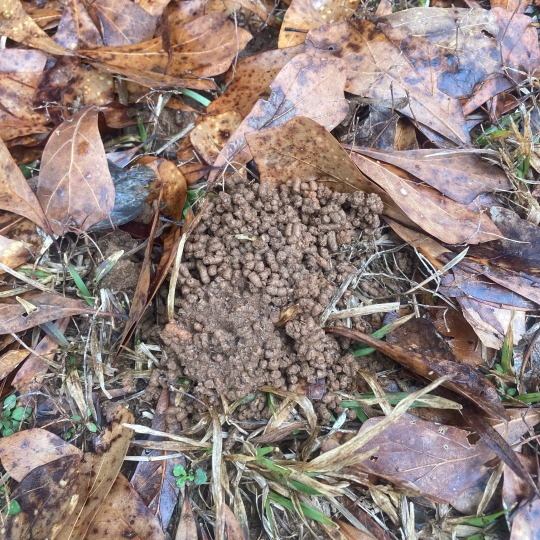
Aeration… air, worm holes, elimination of waste that is a benefit to the entire system. These piles of worm poo give me inspiration. They excite me to continue to create healthy soil. They encourage me to share with others the dimensional joy of observation. Nature is abundant and we are responsible to keep it that way.
Save the soil.
Save the butterflies.
#visionary growing solutions#compost#simple food small farmz#biodynamic#soil#soil biology#atlanta urban ag#biodiversity#permaculture#worms#worm poo#worm castings#simple food small farmz air bnb agriculture experience#simple things#atlanta airbnd experience#air bnb experience atlanta#simple food#maurice small
27 notes
·
View notes
Text
The Food Sovereignty Revolution, Right Down the Street
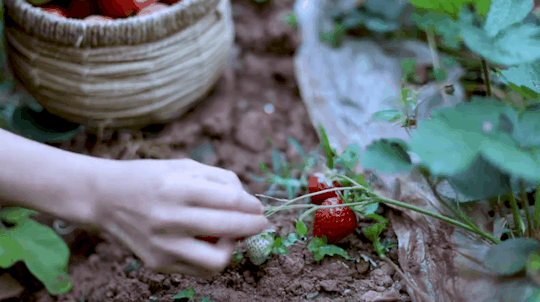
Lemme get on a soapbox really quick about Community Gardens. Because home farms are one thing, local farms are one thing, but nothing can bring people together and inspire confidence like a community garden.
Starting to grow your own food can be a daunting task, with a lot of conflicting information, and it can be difficult when you don’t have the land you need. Having an accessible area for people of all walks of life to come together and experience the trials of food growing makes it easier to inspire people to overcome the learning curve.
I found a nice resource in finding local community gardens by you if you'd like to participate this summer. I also HIGHLY recommend reaching out to anyone you know from Churches, Parks, Schools, Recreation Centers, and other public spaces, and ask them if gardens can be added to their possible developments. I have a few resources on my website for the importance of these gardens if you want to learn more, or send them to people you are trying to convince. It is extremely important that people understand how beneficial this can be for themselves, and their people.
#community garden#garden#gardening#agriculture#agricultural science#farming#farm#community#environmental science#environment#green spaces#green space#solar punk#green revolution#biodiversity#biology#garden blog#plants#sociology#botanical science#earth science#grow your own food#plant science#horticultural science#plant biology#permaculture#veggies
8 notes
·
View notes
